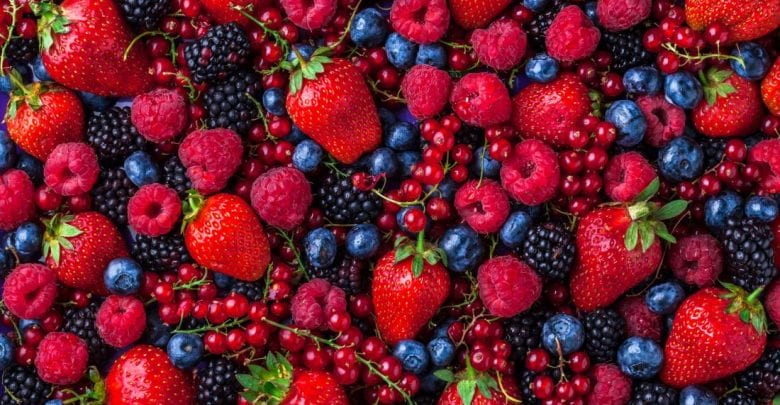
Eating Berries Reduces Your Risk of Heart Attack
“التوت” يخفض خطر الإصابة بأمراض القلب
Berries are one of my super foods, and are represented by the second “B” in G-BOMBS. Rich in fiber and phytochemicals and low in calories, they have the highest Aggregate Nutrient Density Index (ANDI) scores of all fruits. Blueberries, raspberries, strawberries and blackberries are vibrantly colored with antioxidant phytochemicals, and they are some of the highest antioxidant foods in existence.
The deep red, blue and purple pigments of berries are produced by flavonoid antioxidant molecules called anthocyanins, which are concentrated in the skins of the fruits.1 Flavonoids, including anthocyanins, are not merely antioxidants; they are thought to have a number of additional beneficial effects in the body that are unrelated to their antioxidant capacity. In my book, The End of Heart Disease, I cite several studies that have shown that high flavonoid intake is associated with considerable risk reductions (up to 45%) for coronary heart disease.2-5
Recent research highlights the cardio-protective properties of berries
A 2011 study investigated berry consumption in relation to risk for elevated blood pressure. Compared to eating no blueberries, just one serving per week decreased the risk of hypertension by 10%.6,7 New findings published in January 2013 from the Nurses’ Health Study support these results with data in younger women (age 25-42 at the start) who were followed for 18 years. In these women, three or more weekly servings of blueberries or strawberries was linked to a 34% reduced risk of heart attack compared to lower intake of berries.8
How do berries and their colorful anthocyanins protect the heart and blood vessels?
Studies using berries or berry phytochemicals in human participants or on human cells have uncovered some of the possible protective actions of berries on the cardiovascular system. Berry flavonoids seem to act in several different ways to maintain heart health. In human subjects, researchers found that berries mitigated oxidative stress, decreased oxidation of LDL (which helps to prevent the production of atherosclerotic plaque), increased blood antioxidant capacity, and in some cases improved lipid levels, blood pressure or blood glucose.
Higher anthocyanin and berry intake is associated with reduced C-reactive protein (CRP), suggesting that berries may curb inflammation; additional studies have confirmed that berries have anti-inflammatory properties. Berry phytochemicals also may enhance nitric oxide production in the blood vessels, which helps to properly regulate blood pressure.1,9-12
Why not amplify these benefits by eating berries every day?
If observational studies showed a 10% decrease in hypertension risk for one serving of blueberries per week, and a 34% reduced risk of heart attack from 3 servings of berries per week, imagine the protection that is possible when you eat berries every day! Even during winter, we can get our daily dose of anthocyanins from frozen berries. Also remember that in addition to promoting heart health, berries also have anti-cancer effects and provide protection against diabetes and dementia.13-16
source: drfuhrman.com
أجرى باحثون من كلية الملك في لندن دراسة بمشاركة علماء من جامعات ألمانية وإسبانية، أكدت أن تناول التوت قد يقلل من خطر الإصابة بأمراض القلب.
ووجد الباحثون أن المشروب الصيفي البارد من التوت يحافظ على الأوعية الدموية صحية ويساعد على تحسين الدورة الدموية.
وقام الباحثون بفحوصات دم وبول للمشاركين قبل شربهم العصير، وبعد ساعتين من شربه، وبعد يوم من ذلك.
وكشفت النتائج لدى المشاركين الذين استهلكوا مشروب التوت، بعد ساعتين، تمددا أفضل للشرايين بواسطة التدفق (FMD)، وهو اتساع الشريان عند زيادة تدفق الدم، ما يعد مؤشرا على صحة بطانة الأوعية الدموية.
ويعتقد الباحثون أنه إذا كان التوت قادرا على تغيير تمدد الشرايين لفترة كافية، فإنه سيقلل من خطر الإصابة بأمراض القلب بنسبة تصل إلى 15%.
وأظهر تحليل آخر أن هناك زيادة ملحوظة في مستويات مركب اليوروليثين “urolithin” الأيضي للمشاركين مع تحسن تمدد الشرايين. وهذه العملية تنتج بفضل بكتيريا الأمعاء، حيث يقوم الجسم بالاستجابة لمادة كيميائية موجودة في التوت معروفة باسم “ellagitannins”.
وتضاف هذه النتائج إلى القائمة المتزايدة من الأدلة بشأن فوائد استهلاك التوت وخاصة الأحمر.
المصدر: ديلي ميل



